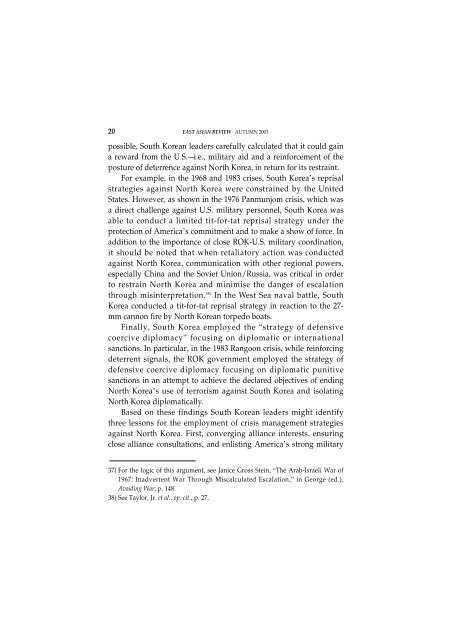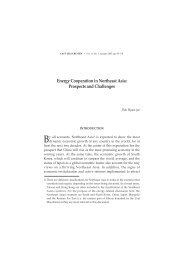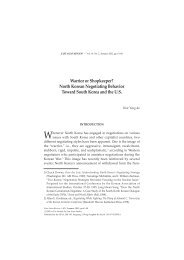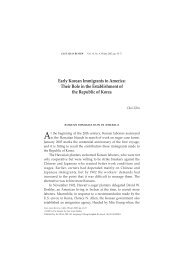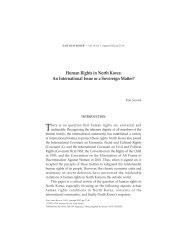Between Peace and War: South Korea's Crisis Management ...
Between Peace and War: South Korea's Crisis Management ...
Between Peace and War: South Korea's Crisis Management ...
You also want an ePaper? Increase the reach of your titles
YUMPU automatically turns print PDFs into web optimized ePapers that Google loves.
20 EAST ASIAN REVIEW AUTUMN 2003<br />
possible, <strong>South</strong> Korean leaders carefully calculated that it could gain<br />
a reward from the U.S.––i.e., military aid <strong>and</strong> a reinforcement of the<br />
posture of deterrence against North Korea, in return for its restraint.<br />
For example, in the 1968 <strong>and</strong> 1983 crises, <strong>South</strong> Korea’s reprisal<br />
strategies against North Korea were constrained by the United<br />
States. However, as shown in the 1976 Panmunjom crisis, which was<br />
a direct challenge against U.S. military personnel, <strong>South</strong> Korea was<br />
able to conduct a limited tit-for-tat reprisal strategy under the<br />
protection of America’s commitment <strong>and</strong> to make a show of force. In<br />
addition to the importance of close ROK-U.S. military coordination,<br />
it should be noted that when retaliatory action was conducted<br />
against North Korea, communication with other regional powers,<br />
especially China <strong>and</strong> the Soviet Union/Russia, was critical in order<br />
to restrain North Korea <strong>and</strong> minimise the danger of escalation<br />
through misinterpretation. 38) In the West Sea naval battle, <strong>South</strong><br />
Korea conducted a tit-for-tat reprisal strategy in reaction to the 27-<br />
mm cannon fire by North Korean torpedo boats.<br />
Finally, <strong>South</strong> Korea employed the “strategy of defensive<br />
coercive diplomacy” focusing on diplomatic or international<br />
sanctions. In particular, in the 1983 Rangoon crisis, while reinforcing<br />
deterrent signals, the ROK government employed the strategy of<br />
defensive coercive diplomacy focusing on diplomatic punitive<br />
sanctions in an attempt to achieve the declared objectives of ending<br />
North Korea’s use of terrorism against <strong>South</strong> Korea <strong>and</strong> isolating<br />
North Korea diplomatically.<br />
Based on these findings <strong>South</strong> Korean leaders might identify<br />
three lessons for the employment of crisis management strategies<br />
against North Korea. First, converging alliance interests, ensuring<br />
close alliance consultations, <strong>and</strong> enlisting America’s strong military<br />
37) For the logic of this argument, see Janice Gross Stein, “The Arab-Israeli <strong>War</strong> of<br />
1967: Inadvertent <strong>War</strong> Through Miscalculated Escalation,” in George (ed.),<br />
Avoiding <strong>War</strong>, p. 148.<br />
38) See Taylor, Jr. et al., op. cit., p. 27.


